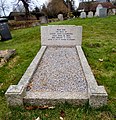
North Hertfordshire is a local government district in Hertfordshire, England. Its council is based in Letchworth.
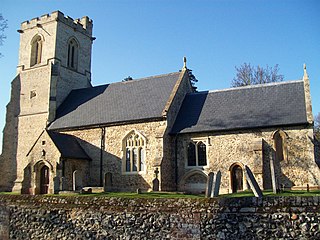
Willian is a village and former civil parish, now in the unparished area of Letchworth, in the North Hertfordshire district, in the county of Hertfordshire, England. Along with Norton and Old Letchworth, it is one of the original three villages around which the garden city of Letchworth Garden City was created. Despite this, the village retains a separate character to the rest of Letchworth Garden City. In 1931 the parish had a population of 210.
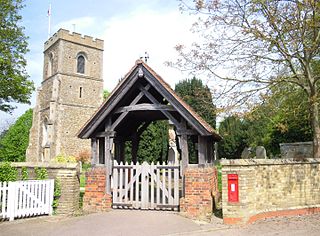
Norton is a small village and former civil parish in Hertfordshire, England, one of the three original villages which were absorbed into Letchworth Garden City, the other two being Willian and Old Letchworth. The village is known to have existed by 1007, with remains of the medieval settlement visible as earthworks in a field beside the church. However, the history of the village goes back even further than that. In 1901 the parish had a population of 169.

Frederick William Pethick-Lawrence, 1st Baron Pethick-Lawrence, PC was a British Labour politician who, among other things, campaigned for women's suffrage.

North Hertfordshire College ("NHC") is a further education and higher education college operating in Stevenage, Hitchin, and Letchworth Garden City. NHC was established on 1st April 1991, through the amalgamation of Stevenage College, Hitchin College and Letchworth Technical College. NHC is graded 'Good with Outstanding features' by Ofsted.

William Harrison Cowlishaw (1869–1957) was a British architect of the European Arts and Crafts school and a follower of William Morris.
Hitchin Rural District was a rural district in Hertfordshire, England from 1894 to 1974, covering an area in the north of the county.

Letchworth Garden City, commonly known as Letchworth, is a town in the North Hertfordshire district of Hertfordshire, England. It is noted for being the first garden city. The population at the time of the 2011 census was 33,249.

Letchworth Museum and Art Gallery was a museum in Letchworth, Hertfordshire, England. It had permanent displays dedicated to the natural history of North Hertfordshire, including the famous black squirrel, as well as its archaeology from remote prehistory to the turn of the twentieth century.

The Hitchin Museum and Art Gallery was a local history museum in Hitchin, Hertfordshire, England, with an extensive collection that told the story of the town’s social history and of the rural industries that contributed to its prosperity.

St Mary's Church is a Church of England parish church in Hitchin, Hertfordshire, England.

The Church of St Mary the Virgin is the Church of England parish church of Letchworth in Hertfordshire. A church appears to have been on the site since before the Norman Conquest. The current church was built in the late 12th century and is Grade II listed. It comes under the Diocese of St Albans. The original dedication of the church is unknown; it was rededicated to St Mary during the First World War.
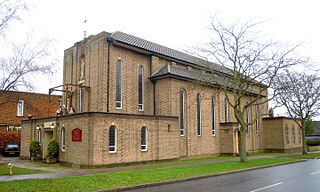
The Church of St Hugh of Lincoln is a Catholic church in Letchworth, Hertfordshire founded by the scholar and priest Adrian Fortescue. The first church was consecrated in 1908 and was dedicated to St Hugh of Lincoln while the modern church which replaced it was built in 1963. It comes under the Diocese of Westminster.

The Church of St Paul in Letchworth in Hertfordshire is the Anglican parish church for the Letchworth Gate area of the town at the top of Pixmore Way. Dating from 1923, with later extensions, it is a 'daughter church' of the nearby Church of All Saints in Willian and comes under the Diocese of St Albans. Built as a 'Victory' church following World War I, the building is the largest war memorial in Hertfordshire.
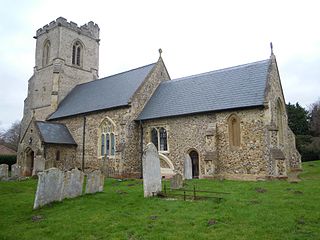
The Church of All Saints is the Anglican parish church for the village of Willian in Hertfordshire. The benefice is united with St Paul's church in nearby Letchworth, although each church has its own parish. It is in the Diocese of St Albans. The church has been a Grade II* listed building since 1954.
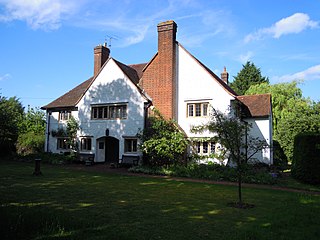
Howgills in Letchworth Garden City, Hertfordshire, England, is a Grade II listed building on the Register of Historic England in use as a Meeting House for the Society of Friends (Quakers).

Hitchin Priory in Hitchin in Hertfordshire is today a hotel built in about 1700 on the site of a Carmelite friary founded in 1317, which was closed in the Dissolution of the Monasteries during the reign of Henry VIII. Parts of the original priory are incorporated in the existing building, which has been a Grade I listed building on the Register of Historic England since 1951.

Hitchin Town Hall is a municipal structure in Brand Street, Hitchin, Hertfordshire, England. The town hall, which was the headquarters of Hitchin Urban District Council, is a Grade II listed building.

Broadway is a road through the centre of Letchworth, in Hertfordshire, England, laid out when the garden city of Letchworth was created. It incorporates Broadway Gardens, and is listed Grade II in Historic England's Register of Parks and Gardens.





